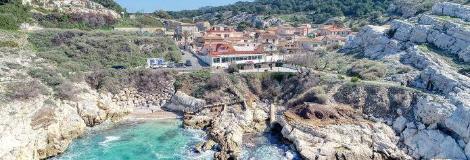Calanques of Marseille: rehabilitation and safety measures for a polluted site
March 2025
Agence pour l’Environnement et la Maîtrise de l’Energie (ADEME)
This natural gem, popular with hikers and swimmers, still bears the scars of a century of industrial activity. Slag deposits, toxic residues from lead ore processing and chemical production, lie on the ground, sometimes even in the water. A major project led by ADEME is starting this year to rehabilitate these polluted areas and protect the population from health risks. Where does this pollution come from?
The pollution of Marseille’s creeks originates from industrial activities in the 19th and 20th centuries, particularly the processing of lead ore and the production of soda and tartaric acid (mainly used as an antioxidant). These industries left behind numerous slag deposits, which were used as fill for the construction of roads and car parks along the coast. These residues contain high concentrations of heavy metals, such as lead and arsenic, which still pose a threat to the environment and public health today, as toxic particles are dispersed by the wind or carried by runoff into the sea. However, as early as 2005, the French National Institute for Public Health Surveillance (INVS) warned of the risks of exposure for residents and the many visitors to the area.

A response commensurate with the problem
In 2012, in response to this situation, ADEME was tasked with securing these critical areas. The objective was to minimise pollution transfer and limit human exposure. Studies launched in 2013 identified and prioritised 20 sites between Mont Rose and Callelongue for treatment tailored to each situation. Two main strategies are being implemented:
-
the total or partial removal of deposits to a specialised hazardous waste storage facility, where technically possible and respectful of ecosystems;
-
the containment of slag using permanent structures designed to withstand erosion by runoff, the sea and wind, integrated into the landscape to limit visual and environmental impact. In practical terms, the slag will be isolated using a waterproof material and then covered to ensure it blends into the landscape.
A tailor-made approach that respects the natural environment
The construction of the containment structures has been carefully studied in consultation with local stakeholders and government departments (DREAL PACA, the departmental directorate for territories and the sea DDTM, ARS, Calanques National Park). To ensure optimal integration into the landscape, technical choices have been adapted on a case-by-case basis, with, for example, the use of limestone gravel (a mixture of sand and gravel) to imitate natural scree, or the cladding of structures with traditional stone walls in the most urbanised areas. All the solutions adopted (removal and/or containment) now make it possible to realistically reconcile health, landscape integration and biodiversity conservation issues (particularly flora and reptiles).
Work is starting this year!
Ten years of studies were necessary to design a management solution adapted to the exceptional environmental context in which the slag deposits to be secured are located (heart of a national park, Natura 2000 site, listed site, etc.). The project is now imminent. The work will be carried out over two seven-month periods, from September 2025 to March 2026 and then from September 2026 to March 2027. This schedule aims to preserve protected species as much as possible while taking into account tourist traffic in the area.